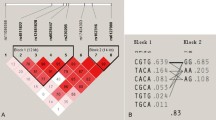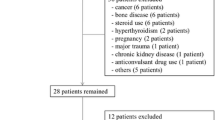Abstract
Parathyroid hormone (PTH) is a principal regulator of calcium homeostasis. Previously, we studied single-nucleotide polymorphisms present in the major genes in the PTH pathway (PTH, PTHrP, PTHR1, PTHR2) in relation to bone mineral density (BMD) and fracture incidence. We found that haplotypes of the PTH gene were associated with fracture risk independent of BMD. In the present study, we evaluated the relationship between PTH haplotypes and femoral neck bone size. Hip structure analysis and BMD of the femoral neck was assessed by DXA in elderly women from the Malmö Osteoporosis Prospective Risk Assessment study. Data on hip fracture, sustained as a result of low trauma, after the age of 45 years were also analyzed. Haplotypes derived from six polymorphisms in the PTH locus were analyzed in 750 women. Carriers of haplotype 9 had lower values for hip geometry parameters cross-sectional moment of inertia (P = 0.029), femoral neck width (P = 0.049), and section modulous (P = 0.06), suggestive of increased fracture risk at the hip. However, this did not translate into an increased incidence of hip fracture in the studied population. Women who suffered a hip fracture compared to those who had not had longer hip axis length (HAL) (P < 0.001). HAL was not significantly different among haplotypes. Polymorphisms in the PTH gene are associated with differences in aspects of femoral neck geometry in elderly women; however, the major predictor of hip fracture in our population was HAL, to which PTH gene variation does not contribute significantly.
Similar content being viewed by others
References
Melton LJ 3rd (1993) Hip fractures: a worldwide problem today and tomorrow. Bone 14(Suppl 1):S1–S8
Cooper C, Campion G, Melton LJ 3rd (1992) Hip fractures in the elderly: a world-wide projection. Osteoporos Int 2:285–289
Arden NK et al (1996) The heritability of bone mineral density, ultrasound of the calcaneus and hip axis length: a study of postmenopausal twins. J Bone Miner Res 11:530–534
Koller DL et al (2001) Genome screen for quantitative trait loci underlying normal variation in femoral structure. J Bone Miner Res 16:985–991
Flicker L et al (1996) Determinants of hip axis length in women aged 10–89 years: a twin study. Bone 18:41–45
Slemenda CW et al (1996) The genetics of proximal femur geometry, distribution of bone mass and bone mineral density. Osteoporos Int 6:178–182
Deng FY, Zhao LJ, Pei YF et al (2010) Genome-wide copy number variation association study suggested VPS13B gene for osteoporosis in Caucasians. Osteoporos Int 21:579–587
Howard GM et al (1998) Genetic and environmental contributions to the association between quantitative ultrasound and bone mineral density measurements: a twin study. J Bone Miner Res 13:1318–1327
Beamer WG et al (1996) Genetic variability in adult bone density among inbred strains of mice. Bone 18:397–403
Nordstrom A et al (2004) Interleukin-6 promoter polymorphism is associated with bone quality assessed by calcaneus ultrasound and previous fractures in a cohort of 75-year-old women. Osteoporos Int 15:820–826
Langdahl BL et al (2003) Polymorphisms in the transforming growth factor beta 1 gene and osteoporosis. Bone 32:297–310
Brommage R et al (1999) Daily treatment with human recombinant parathyroid hormone-(1–34), LY333334, for 1 year increases bone mass in ovariectomized monkeys. J Clin Endocrinol Metab 84:3757–3763
Neer M et al (1993) Treatment of postmenopausal osteoporosis with daily parathyroid hormone plus calcitriol. Osteoporos Int 3(Suppl 1):204–205
Hodsman AB et al (2003) Efficacy and safety of human parathyroid hormone-(1–84) in increasing bone mineral density in postmenopausal osteoporosis. J Clin Endocrinol Metab 88:5212–5220
Chen P et al (2007) Increases in BMD correlate with improvements in bone microarchitecture with teriparatide treatment in postmenopausal women with osteoporosis. J Bone Miner Res 22:1173–1180
Recker RR et al (2009) Cancellous and cortical bone architecture and turnover at the iliac crest of postmenopausal osteoporotic women treated with parathyroid hormone 1–84. Bone 44:113–119
Body JJ et al (2002) A randomized double-blind trial to compare the efficacy of teriparatide [recombinant human parathyroid hormone (1–34)] with alendronate in postmenopausal women with osteoporosis. J Clin Endocrinol Metab 87:4528–4535
Stroup JS et al (2007) Two-year changes in bone mineral density and T scores in patients treated at a pharmacist-run teriparatide clinic. Pharmacotherapy 27:779–788
Kronenberg HM (2003) Developmental regulation of the growth plate. Nature 423:332–336
Stewart AF et al (1980) Biochemical evaluation of patients with cancer-associated hypercalcemia: evidence for humoral and nonhumoral groups. N Engl J Med 303:1377–1383
Tenne M et al (2008) Genetic variation in the PTH pathway and bone phenotypes in elderly women: evaluation of PTH, PTHLH, PTHR1 and PTHR2 genes. Bone 42:719–727
Gerdhem P et al (2004) Association of the collagen type 1 (COL1A 1) Sp1 binding site polymorphism to femoral neck bone mineral density and wrist fracture in 1044 elderly Swedish women. Calcif Tissue Int 74:264–269
Gerdhem P et al (2005) Association between 25-hydroxy vitamin D levels, physical activity, muscle strength and fractures in the prospective population-based OPRA Study of Elderly Women. Osteoporos Int 16:1425–1431
Gerdhem P, Akesson K (2007) Rates of fracture in participants and non-participants in the Osteoporosis Prospective Risk Assessment study. J Bone Joint Surg Br 89:1627–1631
Gerdhem P et al (2007) Associations between homocysteine, bone turnover, BMD, mortality, and fracture risk in elderly women. J Bone Miner Res 22:127–134
Yoshikawa T et al (1994) Geometric structure of the femoral neck measured using dual-energy X-ray absorptiometry. J Bone Miner Res 9:1053–1064
Karlsson MK et al (1998) Bone mineral density assessed by quantitative ultrasound and dual energy X-ray absorptiometry. Normative data in Malmo, Sweden. Acta Orthop Scand 69:189–193
Stephens M, Smith NJ, Donnelly P (2001) A new statistical method for haplotype reconstruction from population data. Am J Hum Genet 68:978–989
Dong SS et al (2009) Association analyses of RANKL/RANK/OPG gene polymorphisms with femoral neck compression strength index variation in Caucasians. Calcif Tissue Int 85:104–112
Cho K et al (2008) Polymorphisms in the endothelial nitric oxide synthase gene and bone density/ultrasound and geometry in humans. Bone 42:53–60
Rivadeneira F et al (2006) Estrogen receptor beta (ESR2) polymorphisms in interaction with estrogen receptor alpha (ESR1) and insulin-like growth factor I (IGF1) variants influence the risk of fracture in postmenopausal women. J Bone Miner Res 21:1443–1456
Moffett SP et al (2005) Tumor necrosis factor-alpha polymorphism, bone strength phenotypes, and the risk of fracture in older women. J Clin Endocrinol Metab 90:3491–3497
Yerges LM et al (2009) Functional characterization of genetic variation in the Frizzled 1 (FZD1) promoter and association with bone phenotypes: more to the LRP5 story? J Bone Miner Res 24:87–96
Zmuda JM et al (2009) Association analysis of WNT10B with bone mass and structure among individuals of African ancestry. J Bone Miner Res 24:437–447
Rivadeneira F et al (2004) The influence of an insulin-like growth factor I gene promoter polymorphism on hip bone geometry and the risk of nonvertebral fracture in the elderly: the Rotterdam Study. J Bone Miner Res 19:1280–1290
Gong G et al (1999) Association of bone dimensions with a parathyroid hormone gene polymorphism in women. Osteoporos Int 9:307–311
Ahlborg HG et al (2005) Contribution of hip strength indices to hip fracture risk in elderly men and women. J Bone Miner Res 20:1820–1827
Faulkner KG et al (2006) Femur strength index predicts hip fracture independent of bone density and hip axis length. Osteoporos Int 17:593–599
Beck TJ (2007) Extending DXA beyond bone mineral density: understanding hip structure analysis. Curr Osteoporos Rep 5:49–55
Gregory JS, Aspden RM (2008) Femoral geometry as a risk factor for osteoporotic hip fracture in men and women. Med Eng Phys 30:1275–1286
Gluer CC et al (1994) Prediction of hip fractures from pelvic radiographs: the study of osteoporotic fractures. The Study of Osteoporotic Fractures Research Group. J Bone Miner Res 9:671–677
Duan Y et al (2003) Structural and biomechanical basis of sexual dimorphism in femoral neck fragility has its origins in growth and aging. J Bone Miner Res 18:1766–1774
Lei SF et al (2005) The VDR, COL1A1, PTH, and PTHR1 gene polymorphisms are not associated with bone size and height in Chinese nuclear families. J Bone Miner Metab 23:501–505
Uusi-Rasi K et al (2005) Effects of teriparatide [rhPTH (1–34)] treatment on structural geometry of the proximal femur in elderly osteoporotic women. Bone 36:948–958
Parkinson DB, Thakker RV (1992) A donor splice site mutation in the parathyroid hormone gene is associated with autosomal recessive hypoparathyroidism. Nat Genet 1:149–152
Kilav R, Silver J, Naveh-Many T (2001) A conserved cis-acting element in the parathyroid hormone 3’-untranslated region is sufficient for regulation of RNA stability by calcium and phosphate. J Biol Chem 276:8727–8733
Kaptoge S et al (2008) Prediction of incident hip fracture risk by femur geometry variables measured by hip structural analysis in the study of osteoporotic fractures. J Bone Miner Res 23:1892–1904
Acknowledgements
Support for the study was received from the Swedish Research Council (grant K2009-53X-14691-07-3), the Greta and Johan Kock Foundation, the A. Påhlsson Foundation, the A. Osterlund Foundation, the Malmö University Hospital Research Foundation, the Research and Development Council of Region Skåne (Sweden), and the Swedish Medical Society. Thanks are also extended to Jan-Åke Nilsson for statistical advice.
Author information
Authors and Affiliations
Corresponding author
Additional information
The authors declare no conflict of interests.
Rights and permissions
About this article
Cite this article
Tenne, M., McGuigan, F.E., Ahlborg, H. et al. Variation in the PTH Gene, Hip Fracture, and Femoral Neck Geometry in Elderly Women. Calcif Tissue Int 86, 359–366 (2010). https://doi.org/10.1007/s00223-010-9351-6
Received:
Accepted:
Published:
Issue Date:
DOI: https://doi.org/10.1007/s00223-010-9351-6




